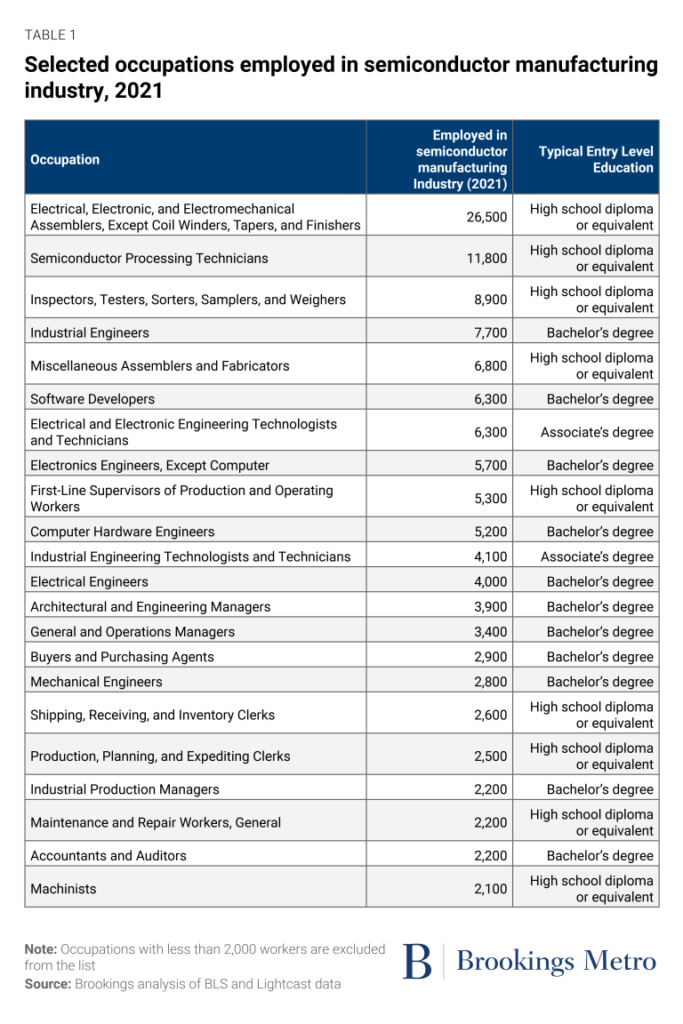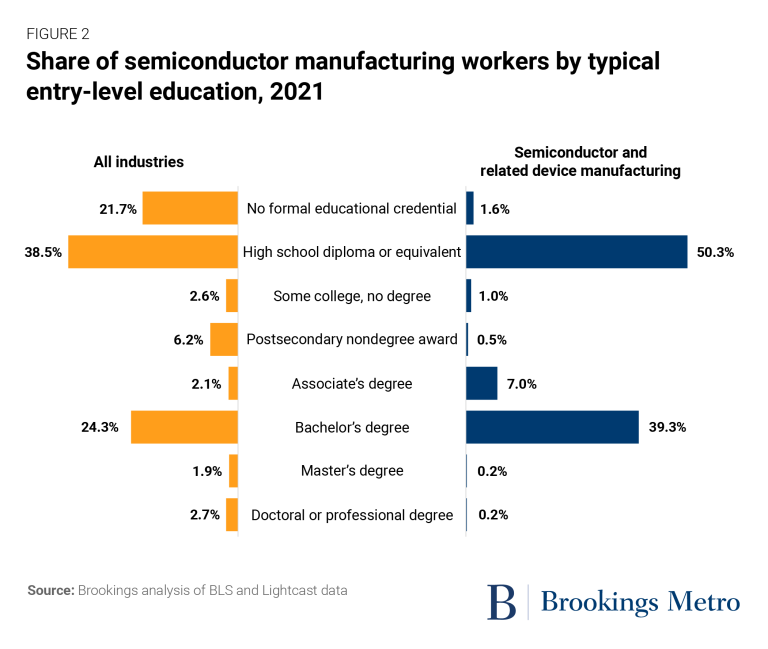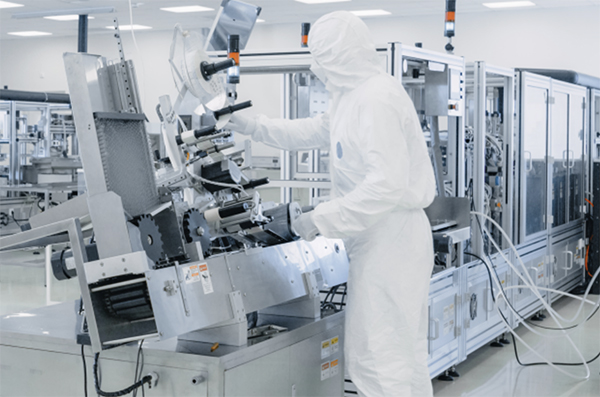One of the most auspicious aspects of the Biden administration’s surge in industrial policy legislation is the possibility of creating thousands of new, accessible, and tech-related blue-collar and “new-collar” jobs for people without college degrees.
The potential for such work has been most widely championed in the context of the Infrastructure Investment and Jobs Act and the Inflation Reduction Act. Less noticed, though, is the potential of last summer’s
CHIPS and Science Act, which seeks to reignite domestic semiconductor manufacturing after decades of offshoring.
Through the CHIPS and Science Act, the subsidiary
CHIPS Act of 2022 appropriates $39 billion to subsidize the construction or expansion of U.S. fabrication plants for both leading-edge logic and memory components as well as mature-technology semiconductors. This has already prompted multibillion-dollar investments in
Columbus, Ohio, Syracuse, N.Y., and
other areas. Such manufacturing facilities promise a solid source of good jobs—including for people with fewer formal degrees, lower-income people, and people in non-coastal areas of the U.S.
But achieving such outcomes depends on what might be one of the hardest transformations for the U.S. to achieve in the semiconductor field: a major surge of national, state, and local actions to expand, train, and diversify regional workforces to ensure more workers can participate in the industry’s growth.
Building new semiconductor manufacturing plants will not by itself produce accessible pathways for local workers and meet employer demand. Instead, regions must organize themselves, leverage existing assets, and build stronger employer-education-government links that create the pathways needed to ensure local workers truly benefit from the semiconductor opportunity.
What follows provides a look at the nature of the semiconductor workforce opportunity, as well as early signals on preparing for that opportunity in the Columbus, Ohio area, where the first major use of CHIPS Act subsidies has triggered planning for an industry-relevant workforce development system.
SEMICONDUCTOR JOBS ARE SURPRISINGLY ACCESSIBLE
The idea that onshoring more computer chip production might benefit historically marginalized communities and less highly credentialed workers remains a point of contention for many.
High-tech work of any sort is frequently assumed to involve complex software development or data analysis, and therefore thought to be exclusive. What’s more, the workforce discussion in the semiconductor industry has tended to focus less on technicians and more about the need for attracting immigrant Ph.D.s and getting more students into STEM fields to support high-end design processes. Broader discussions about pathways for underrepresented workers into the industry haven’t often been prominent.
Yet fabrication plant work holds out real promise for workers who lack formal degrees but are interested in increasing their pay by upskilling with specific credentials and certificates. While one-third of semiconductor industry jobs reside in higher-skill design activities, two-thirds—some 187,000 workers—are in the manufacturing workforce, according to Brookings Metro analysis of Bureau of Labor Statistics data.

These jobs—including thousands of technicians to oversee and manage the manufacturing process—are significantly more accessible than design jobs in terms of their degree requirements (though significant levels of technical skills are often needed). In fact, across the manufacturing side of the industry, 60% of jobs don’t require a bachelor’s degree; employees hold everything from an associate degree or a postsecondary non-degree to a high school diploma or no degree.


In short, any successful surge of semiconductor manufacturing across the U.S. will require not just university-credentialed design professionals but also significant numbers of less formally educated technicians and related workers. The hope is these latter roles can be filled by underrepresented workers in regions and communities the previous decade’s tech boom left behind.
SEMICONDUCTOR JOBS PAY WELL, INCLUDING AT LOWER EDUCATION LEVELS
Semiconductor manufacturing jobs aren’t just accessible—they’re also good-paying. However, these jobs are not hugely numerous right now in the U.S.,
nor will the CHIPS Act massively multiply their numbers. In fact, employment in semiconductor manufacturing has been declining in the U.S. over the last decade.

Even with the creation of six or 10 new fabrication plants in the next few years, the U.S. would see only moderate direct employment gains nationally. (Though, significant indirect and induced employment would follow, as would the rise of dense local employment clusters.)
Still, any growth in the U.S. semiconductor manufacturing industry holds the potential to create numerous well-paying jobs in and around new fabrication plants. Job postings data from Lightcast shows that between October 2021 and October 2022, starting positions in semiconductor manufacturing (which don’t require bachelor’s degrees) paid a median wage of $48,000—significantly more than the non-college median wage of $40,000 across all industries. Median pay in semiconductor jobs can rise within two to three years, and the workforce training strategies described below allow for worker enrichment and a focus on career pathways beyond the entry-level positions.
CENTRAL OHIO’S EFFORTS AT TRAINING AND INCLUSION FOR THE SEMICONDUCTOR WORKFORCE
Ensuring broad engagement of diverse workers in semiconductor manufacturing will require building up the requisite talent pipelines, including recruiting, training, and retaining more and different types of workers.
Few new approaches to this training pipeline currently exist. Moreover, new semiconductor manufacturing jobs tend to require a more technical skillset than entry-level jobs of the past. For instance, Intel’s manufacturing technician positions require workers to perform all functions associated with wafer production (a thin slice of semiconductor) as well as operate, maintain and repair specialized processing equipment inside and outside a clean room environment that simultaneously retains high output and adheres to high safety standards.
However, the central Ohio (Columbus) region—site of the first new fabrication plant associated with the CHIPS Act—is one place to look for ideas on how to deliver on the promise of accessible semiconductor manufacturing jobs. There, construction of Intel’s $20 billion facility is already underway, as are local leaders’ plans for innovating and scaling the region’s workforce training pipeline. As such, the Columbus plant represents a test of the nation and its regions’ ability to facilitate large-scale economic inclusion by ensuring sizable numbers of workers can access training pathways toward semiconductor manufacturing occupations.
An example of a new dual approach to recruiting and preparing non-degreed workers for semiconductor manufacturing jobs is being spearheaded by the local community college and workforce boards. Columbus State Community College (CSCC) is leading the development of a novel statewide strategy to tackle the new facility’s workforce demands and fill approximately 2,000 non-degreed jobs (not including Intel’s suppliers, which will also be generating new positions). At the same time, the local workforce board is sharpening its intermediary role as a convener of training organizations and scaling up a “no wrong door” philosophy that enables greater access to the training pipeline for all workers.
To design and build a statewide strategy that meets the expansive needs of Intel’s technicians and suppliers, CSCC partnered with the Ohio Association of Community Colleges to recruit and train workers from community colleges across all corners of Ohio. According to Rebecca Butler, executive vice president at CSCC, the goal is to generate a statewide marketing and training template and campaign, with prospective workers routed through their local community college. The training template, along with CSCC’s other statewide work, is “open source” and non-proprietary, and intended to align the state’s relevant training institutions and prime the flow of workers to meet Intel’s employment needs.
Under this statewide strategy, CSCC has adopted two distinct training priorities. First is a short-term certificate program for upskilling existing workers; second is a curriculum-enhancement approach to widen job prospects in the long term.
The first priority encourages individuals already working in adjacent advanced manufacturing fields to pursue a one-year certificate that is stackable and transferable. It is meant to ensure that entry-level technicians across the state start with similar foundational skills (including digital literacy) and the basic competencies needed to thrive in the those positions and for longer-term success. Eventually, CSCC aspires to build a dual-credit program so area high school students can obtain the certificate and an assured job—a game-changer for many young people.
The second priority involves infusing engineering technology degree and certificate programs with additional skills training. Based on skills competency mapping, 80% of these program’s curricula already aligns with what Intel’s jobs require; the focus now is on enhancing the remaining 20% with new subject matter. Intel is the catalyst for this effort, but Ohio has long needed such an investment in statewide advanced manufacturing talent development strategies.
CSCC’s multifaceted recruitment and training pipeline strategy was developed in part by bringing together a mix of state-level leaders (including the Ohio Manufacturers’ Association and JobsOhio, the state’s public-private business attraction and retention economic development arm) and the Ohio Association of Community Colleges. CSCC and its workforce training partners acknowledge that Ohio’s working-age population largely lacks the right skills for relevant technology positions, particularly when recruiting from diverse communities; to address this, they are designing the program to attract and train women and members of the Black and brown communities. And in some instances, CSCC is assembling funding packages that ease the burden on students and remove barriers to entry.
USING LOCAL WORKFORCE BOARDS AS CONVENERS
In parallel to CSCC’s statewide efforts, central Ohio’s public workforce development boards are intensifying their role as conveners. In particular, the Workforce Development Board of Central Ohio has brought together a range of training providers and three other workforce boards covering districts adjacent to the Intel facility—not only to serve Intel, but to also meet demand from other employers as well.
Workers’ skills should be relevant not just for Intel, but also across other companies in the region, such as Honda and its recently announced electric vehicle battery production facility. As Lisa Patt McDaniel, CEO of the Workforce Development Board of Central Ohio observed, the local workforce boards see a long-term opportunity to build up a non-degreed workforce with transferable skills that will enrich the region’s advanced manufacturing workforce base, supply trained workers to other plants, and provide a multiplicity of career pathways.
The workforce boards are navigating other challenges, including an unsettled question about whether the associate degree that Intel requires for its workers could instead become a proxy for relevant skills (for instance, HVAC workers who have transferable skills but do not have a degree). Such a substitution could plug workers into the talent pipeline faster. Likewise, the Midwest’s training landscape has unique institutional players, such as career technical education centers, and the semiconductor sector will need to adjust its training requirements to work with them.
The region’s workforce boards are also scrambling to help fill the estimated 7,000 construction jobs needed before the Intel facility even opens its doors. They are taking on special recruitment efforts that involve significantly augmenting wrap-around services (e.g., child care, career counseling) to better enable and prepare workers to access these jobs.
How well the workforce boards collaborate with community colleges, Intel, and other actors will have a significant impact on whether central Ohio really will capitalize on the semiconductor facility’s opportunity and draw more of its non-degreed workers into high-quality work in semiconductor manufacturing.
FEDERAL MANUFACTURING SUBSIDIES ALONE AREN’T ENOUGH
Central Ohio education and workforce leaders have recognized the need to take extraordinary measures to ensure their region and its workers reap the benefits of semiconductor production. Accordingly, they are preparing their region by planning and innovating, building on existing assets, collaborating creatively, and breaking down traditional silos.
While these new strategies are independently promising, they remain somewhat ad hoc. Ideally, local institutions will further organize and align their efforts, including the interplay of CSCC’s statewide recruitment strategy and local workforce boards’ sector-based training focus on advanced manufacturing jobs. Local and regional coordination among multiple institutions and partners is critical, but hard to wrangle even under normal circumstances.
Such coordination and alignment are sorely needed to train and fill the talent pipeline. However, the degree and type of collaboration required for success is rare in most of the country’s regional workforce training systems, and it may not happen without external impetus—whether that be further federal incentives and/or oversight from a state-appointed coordinator.
Given this, the federal government’s basic subsidies are necessary but not sufficient for channeling skilled non-degreed workers into new tech-based jobs. Local partners would instead benefit from federal funding incentives directly for workforce development: Some $125 million (of an approved $200 million) has been made available through the CHIPS and Science Act for workforce training that bolsters the talent pipeline of skilled technical workers for new semiconductor facilities. However, these funds—to be managed by the National Science Foundation—will need to be carefully integrated into the national semiconductor initiative so they become readily available for organizations currently grappling with the workforce training pipeline.
Moreover, while regions can leverage existing assets and find new ways to align employers, educational institutions, and other training entities, new cross-governmental partnerships may also be required. Given that, it is imperative that state and federal policymakers partner with regional entities in fostering a new degree of local “readiness,” which exists in few places today, especially at the scale needed in central Ohio. In this regard, preparation of the upcoming Notice of Funding Opportunity (NOFO) for the CHIPS Act offers federal agencies a unique opportunity to provide special incentives for states to partner with local actors to scale up their collaborations and deliver on the promise of new semiconductor manufacturing for working people.

